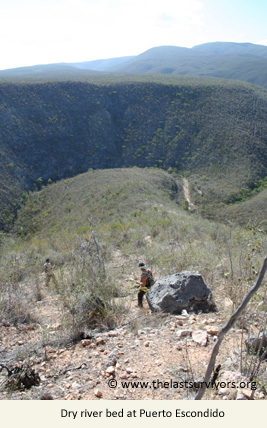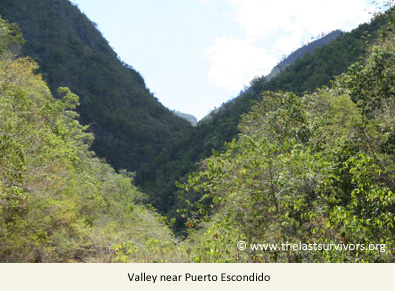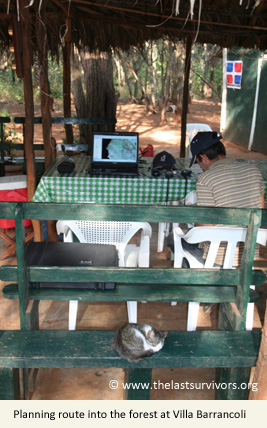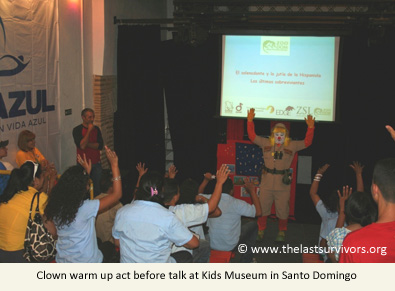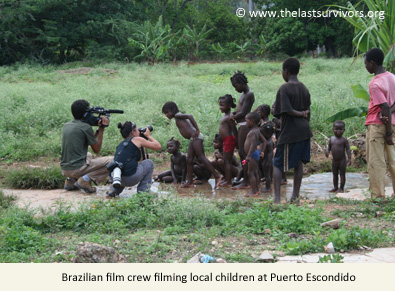Back in the UK you have been experiencing the arrival of spring, here on the Island of Hispaniola we are still waiting for our next season to start in earnest – namely the rainy season.
The island is currently experiencing a bit of a drought and although this is not a good thing in general, it has meant that we have managed to avoid any major soakings since our last update. That’s not to say that no rain has fallen, it just means we have not been caught out in the field when it has. However, instead we have had to cope with searing hot temperatures in order to look for solenodon and hutia in remote sites which can only be accessed via very long treks through areas of dry forest with little or no shade. It’s been tough going!!
Luckily for the Dominican Republic and unlike its neighbour Haiti, a lot of its land is still covered in forest which has allowed it to withstand the worst effects of the current drought relatively well. The main area where we have been working since our last update is the north of sierra de Bahoruco national park where it seems that since the creation of the park there has been some natural regeneration of the forest in what was previously agricultural land.
Happily we found lots of signs of solenodon in the area and we managed to capture two individuals in order to take genetic samples. Unfortunately we did not encounter any hutia populations. While working in this area we were very lucky to be able to stay in a small community called Puerto Escondido at the Tody Tours campsite which is owned by Kate Wallace. Kate and her bird touring company is yet another organisation that has leant its support to the project, something we are particularly grateful for since it meant we were staying in relatively luxurious comfort after our very long sweaty treks into the surrounding forest.
Solenodon have been in the national press over the last few weeks since at least two individuals were caught by local villagers in an area that was being cleared for agriculture. This area, named Hato Mayor, is in the east of the island and is the same area where a farmer caught a couple of solenodon 44 years ago, causing a lot of debate in the national newspapers back then. There is some cringe-worthy TV footage of one of the animals caught recently which you can watch here. Sadly these animals were caught during the day (remember they are strictly nocturnal!) as they searched for a new home after their habitat was destroyed. One animal was later released while another was taken to the National Zoo (one of the project collaborators) to be taken care of while a new location for it to be released into is found.
The Ministry of Environment and Natural Resources has called for a halt to any further land conversion in the area until the status of the solenodon community is established. We held a press conference in order to lend our support to the ministry and to inform the wider public of how solenodon are fairing in areas where forest is being allowed to return and in other areas where its being cut down – this all reflects the very mixed picture for solenodon across this large Caribbean Island.
We have been holding a series of talks for kids aged between 4 and 14 at the Kids Museum in Santo Domingo, the capital city of Dominican Republic. Kids from all over the country came to the talks and it was interesting to see how few of them (less than 1 in 10 on average) knew about their last two endemic non flying land mammals. They were all fascinated to find out about them and their obvious pride in them was easy to see. Hopefully it will inspire some of them to take an active role in conservation in the future.
The international press have continued to show a lot of interest in the project and we did a couple days of filming with a Brazilian TV programme called “Wild Adventure”. An hour long programme about the project will be televised later on this year in one of the most widely viewed wildlife programmes in Brazil.
On a completely unrelated front, we are in the grips of election madness here in the Dominican Republic with a major congressional election happening ten days after the one in the UK. The whole country will be electing 32 senators and 178 local representatives. Every road and village is covered in all the different flags representing the various parties, its definitely making the whole place very colourful and interesting to drive through as we travel to our field sites.
Thanks from all “the last survivors” team for your support and encouragement. Don’t forget to get in touch with any questions or comments.
by Pedro Martinez and Jose Nunez-Mino The Last Survivors
